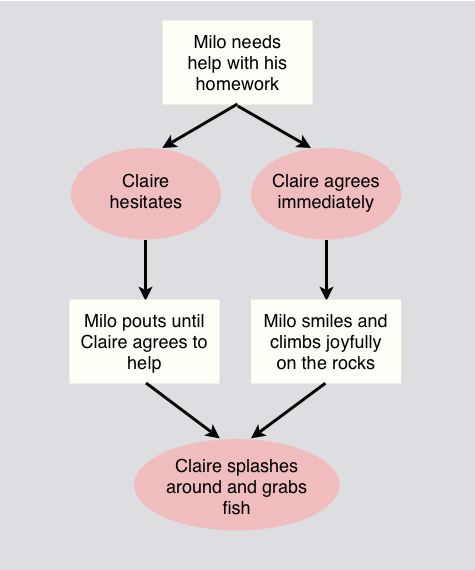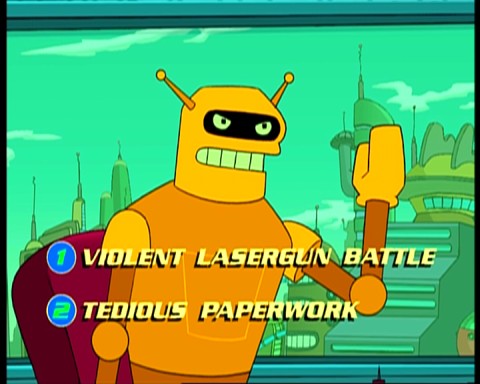
Okay, so I've never actually fallen in love with a character from a video game. But I have felt a certain connection with some video game characters (especially Non-Player Characters, or NPCs); you probably have, too. As games develop, we'll have more of these friendships — and they'll become more meaningful. The possibility for genuine human connection with virtual beings is becoming more and more powerful as time goes on. The amazing thing is: It has almost nothing to do with technology.
I'll admit right up front that what follows is kinda long. There's lots of words here, and I won't be offended if some people take an attitude of TLDR. But these are important philosophical concepts, and I want to see the conversation move beyond the stale, boring black-and-white argument of "yes it is"/"no it isn't".
Prelude: The Buzzing, Dissonant Gap
In his landmark 1993 article A Rape in Cyberspace, Julian Dibbell describes the difficulty of understanding why a virtual sexual assault so deeply affected those involved. It's a fascinating piece, and you really should read the whole thing. But to summarize, here's what happened: In one of the earliest online text-based communities, LambdaMOO, one user virtually raped another. No physical violence took place, of course — it was all just people sitting at computers. But those involved felt genuine trauma.
So the question is: What actually happened? As Dibbell puts it:
virtual reality and its conventions would have us believe that legba and Starsinger were brutally raped in their own living room [...] real life, on the other hand, insists the incident was only an episode in a free-form version of Dungeons and Dragons, confined to the realm of the symbolic and at no point threatening any player's life, limb, or material well-being [...]. Ludicrously excessive by RL's lights, woefully understated by VR's, the tone of legba's response made sense only in the buzzing, dissonant gap between them.
The point is this: It's obvious that our connections to other people online (and, I will soon argue, NPCs) are not real. It's make-believe; it's all in our heads. But it's also unfair to say that these connections don't exist at all. There is something real that comes from our virtual relationships, whether they're good or bad. And while modern forms are more viscerally engrossing, these relationships are nothing new.
I. Robots Are People, Too
Everyone has felt connected to a fictional character at some point. It's an ancient concept; the Greek sculptor Pygmalion fell in love with his statue. You've probably cried at the end of a movie, or found yourself hoping — even praying, perhaps — that a certain man or woman on TV or in a book won't die. It doesn't happen nearly as often as Hollywood would like it to (for reasons we'll examine in the next section), but it happens. I was profoundly affected by the German movie The Lives of Others. Every time we read Macbeth in my English class, I feel a new kinship with that paranoid homicidal man. And the characters in graphic novels like Watchmen and Preacher show that it can be done in comics, too.
The key in each case is the emotional connection we make with the fictional characters. Obviously the medium matters, but it doesn't matter nearly as much as the quality of the characters and how well the story is told. Pacing, imagery, dialogue, tone, and mood — these things exist in all media, and those precious few artists who work to use them effectively are the only people who can forge the connection.
So what about video games? Well, I will say in response, what about them? They're stories, and just like any other form of storytelling, it's a mixed bag. We get a lot of dumb, cookie-cutter movies, and a few fantastic gems. We see piles and piles of mass-market crap on the bookstore shelves, and a couple of magnificent works here and there. So it's no surprise that video games are mostly formulaic repeats and reruns; it's the small percentage of absorbing, polished masterpieces that really make a difference.
Take Mass Effect and Dragon Age: Origins, for example. BioWare has done a beautiful job of using well-paced episodes of dialogue and the player's free will (limited though it still is) to establish a meaningful connection between the player and the NPCs. I was genuinely nervous when it looked like Wrex might die in Mass Effect. I managed to save him, and I quickly realized that it was because I really wanted him to live.
While playing Dragon Age, I felt a sincere warmth toward Morrigan. It wasn't actual romance, of course, but it went beyond the superficial "relationships" I'd seen in Fable II. I liked Morrigan's cynical attitude, her humor, and her honesty. (Some of the same personality traits I most love about my wife.) I was actually hurt when Morrigan left at the end of the game — and not just because I had built my entire combat strategy around her.
I'll even admit that Heavy Rain occasionally hit the right notes in creating a bond with the characters. When struggling to get out of a tight spot (or tight ropes in a psychopath's basement), I got a bit panicked; there was a genuine fear there, and a genuine relief when I escaped. Too bad it was canceled out by all the dumb, fake, moronic pseudo-emotion in other parts of the game. ("Jason. Jason. Jason. Jason.")

And hopefully I don't need to explain why Red Dead Redemption fits in here. (Assuming you've finished the singleplayer story.) Many people I know have said it's the most affected they've ever been during a game. Again, it's because the character reaches us. The people are fake, the world is fake, the horses are fake, the guns are fake — but our connection with John Marston is real.
Maybe this is because the player is John Marston. Or maybe not.
II. How Important is Technology?
Some people say that we feel a connection to John Marston and Madison Paige because we experience their lives from a first-person (or third-person) point of view. This idea makes sense — we are literally (well, virtually) walking a mile in the character's shoes (or boots). We see what they see, hear what they hear. When an NPC talks, s/he is talking to us. Conventional wisdom suggests that we will naturally merge into the identity of the main character, and forge a deep relationship.
But the conventional wisdom is wrong, and Exhibit A is Commander Shepard from Mass Effect. Think about it — how much do you really know about him? (Or her? My Shepard is female, named Martha after the protagonist of Frank Miller's graphic novel Give Me Liberty.) Almost nothing, since everything Shepard does or says is selected by the player. As much as I love my Shepard, I recognize that she is basically a 1:1 extension of myself. She never says anything that I haven't told her to say. (I can usually only choose between 3 or 4 options — and some of them are nearly identical, which I don't understand — but I do have some choice.) She never does anything that doesn't correspond to a button or thumbstick action of mine. We even get to choose Shepard's backstory. The character is completely mediated by the player.
John Marston, on the other hand, is largely (maybe even mostly) autonomous. Sure, we get to choose whether to chase the bad guy who stole the lady's wagon, even choose whether to shoot him dead or bring him back alive. But those are minor decisions with very little impact on the story itself — and therefore, on the character himself. We don't really get to choose whether John is a good guy or a bad guy, any more than we got to choose whether CJ in San Andreas would stand up to the corrupt cops on Grove Street.
Paradoxical as this may seem, it's actually at the core of connecting to a character. If we're completely in control of a character on the screen, that character becomes a simple extension of us. As a result, we feel connected to ourselves. That's not new, and it's not profound; it's a basic storytelling tautology. Do you feel connected to yourself? Duh! (Okay, some people who have never really thought about who or what they really are — Thomas Anderson before he becomes Neo — might not feel connected to themselves. Or people with Multiple Personality Disorder.)
In the cases of both John Marston and Morrigan from Dragon Age, the true connection comes in spending time with this other person, getting to know her/him, finding common ground, giving and receiving, sharing joy and pain — the stuff of all relationships. And while some technophiles are gushing about how new technologies allow these relationships to get deeper and more numerous, the exact opposite may be true.
III. Milo is a Stupid Robot
Peter Molyneux is one of those technophiles. You may remember when he wet his pants at E3 2009, ranting and raving about how deeply the player, Claire, connects to his new virtual creation Milo. To hear Mr. Molyneux (and his fanboys) tell it, technological advances like facial recognition and image-scanning will make your connection to Milo much deeper and more profound than anything you've experienced before.
But let's take a step back and look at how the story itself will be told. (And obviously, the same questions should be asked about which story gets told in the first place.) Let's imagine a simple tree-branching diagram for the story of Claire and Milo:
[caption id="attachment_595" align="aligncenter" width="350" caption="Fig. 1: The Real Milo Demo"]
 [/caption]
[/caption]So far as I can tell, this is the basic scenario from the 2009 E3 demonstration. Milo senses Claire's hesitation, and responds in a way that will get him what he wants — Claire's help. The point is this: Whether he hesitates or not, sooner or later she will be down in the water, helping him gather fish.
Obviously this is a simplified tree, and a full game would increase the possibilities. So let's imagine what might happen if other possibilities were added into the mix. Not only options for Claire (hesitate or agree immediately), but options for Milo, too:
[caption id="attachment_596" align="aligncenter" width="350" caption="Fig. 2: Alternate Milo "]
 [/caption]
[/caption]Notice how just a couple of small changes in what's possible can lead to three very different outcomes. We're not being led down an inevitable path, where our input has only a minor impact on the outcome. Now we're moving down a series of paths which branch significantly — and (this is key) may or may not result in the same outcome.
Heavy Rain tried to offer this sort of vast branching related to player input. And it was of course possible that the player would fail miserably, the kid would die, and it would all end in tears. But for most of us, regardless of what we did or did not do, we ended up at the construction site, fighting the big bad man with one or another of the main characters. The fight may have taken place in a different part of the site, Ethan may or may not have been the first to hug the child, but the outcome was more or less the same.
Partly, this had to do with the scenario: The kid was always at Location X. Therefore, there weren't many possible ways to end the story in a successful way. But imagine (Heavy Rain 2.0) that the player's goal had not been to rescue a trapped child from Location X, but instead to escape from a killer. Imagine the big bad man had said: "I will abduct your child in one week unless you do the following things." Then, one end of the tree might result in father and son living happily ever after in Brazil. Another might have them living happily ever after in Japan, based on choices the player made during the game. Another might have the father die, while the son escapes to Japan or Brazil. Or some third country.
In both of my re-imagined story trees (Heavy Rain 2.0 and Alternate Milo), the player would feel a more significant connection to the other characters because s/he would see significant effects of their actions, resulting in reasonable outcomes that are not predetermined. (Well, okay, they're less predetermined.) The point is this: Natal (or Kinect, or whatever Microsoft wants to call it) has almost nothing to do with the depth of this connection. All it does is add a new possibility for how the player will communicate with Milo — it does not significantly affect the range of options that communication opens up.
For each new story tree I've suggested, the key question is: How much time is the storyteller willing to invest in creating all of those branches? (And, obviously, creating new environments, new character animations, new voice acting, etc etc.) Each branch requires a significant investment of time and money and effort. (And the player might never even see it!) It's obviously much easier for a company like Quantic to bring each branch of the story back to Location X, meaning they only have to create one location for the end of the game. (True, they have to do different character animations and voice acting, but they're saving money on environments.)

The same is true of Milo — if Mr. Molyneux were to implement the Alternate Milo tree that I've suggested, he'd need to create a new environment for him to storm off to when he wants to be alone. Milo would also have to have a more sophisticated AI that can not only recognize human facial expressions, but choose from a vast array of options about how to react.
And here's the point (finally): The more time developers spend on shiny graphics and cutting-edge technology like Natal/Kinect, the less time they'll spend on creating the branching story trees required for deeper character connection. Simple as that.
IV. Movies vs. Games
So if branching storylines are necessary for good character development in games, but we don't really control John Marston (that story tree doesn't have too many branches), then how can I present it as an example of superb character connection in a video game? It's because, for the purpose of this discussion, Red Dead Redemption is really functioning more like a movie than a video game. We're mostly just watching Marston's story unfold before us, and controlling him during the most exciting bits.
And this is where the unique opportunity for NPC character relationships exist within video games. We cannot influence anything that happens in a movie. They tried for a little while with mini-controllers in movie theatres, where everyone in the audience chose one option or another, and then the majority choice was presented. (In one episode of Futurama, a movie audience is asked whether the robot Calculon should engage in a "Violent lasergun battle" or complete "Tedious paperwork".)

But video games offer us the unique opportunity to take actions that the other character will respond to. That's what real-life relationships are made of, and the more sophisticated video-game story trees become, the more those interactions will mirror real life.
Eventually we will go beyond just being good vs. evil (or paragon vs. renegade, or what have you). I can imagine a game ten years from now that also allows us to act with jealousy, indifference, sarcasm, sincerity, or overdone dramatics. And — just as in real life — the subtle shades of difference in our actions will lead to subtle differences in reactions from NPCs.
V. Have You Ever Loved a Dog?
Some people claim that our relationships with virtual people can't go very far, because their ability to communicate is limited by technology, or because they can't think like people. Even if we accept that the technology is rapidly developing to remove the communication barrier, some folks say that there will always be barriers between the virtual and the real, because of the differences between us and them.
But we cross these barriers all the time. Don't we frequently connect with other people and things that can't think or communicate the way we can?

This is my old dog, Eileen. She was a sweet, playful, happy dog. She died in January 2009. I had lost dogs before — two, in fact, when I was growing up. But Eileen's death affected me more powerfully than either of those other losses, which is odd, if you consider the deep emotions that usually come with childhood.
My love for Eileen had nothing to do with her being human-like, and everything to do with the two of us getting to know each other. Sometimes she would do things I didn't expect — sit on the other side of the couch, for example — and I'd have to incorporate that new piece of information into my understanding of who she was. More than anything, this took time. The more time we spent together, the more deep our connection became. Giving her a device to help her speak might have made our connection deeper, but probably not. (As Wittgenstein said: "If a lion could speak, we would not understand him.") So, again, it's about experiences, not technology.
Conclusion: The Adolescence of Video Games
I will end by returning to a point I made at the start: The increasing depth of character connection through video games has nothing to do with technology, but we will see more of these connections as time goes on, and they will become more meaningful. Why is that true, if it's not related to the steady advance of technology?
Here's why: Because the video game is a very young art form. (Yes, it's an art form. Play the entire singleplayer campaign of Red Dead Redemption or please be quiet, Mr. Ebert.) For the past 30 years, most game developers have only focused on the graphics, the sound, the gameplay elements. Most games in the first two decades didn't have much of a story at all. (Even Robyn Miller, creator of the groundbreaking puzzle game MYST, told me that he didn't include any story at all in that game.)
But we've reached a critical point in the maturation of video games. A few developers — hopefully their numbers are growing — have come to understand what's really important in making a game that will connect player to character. And they realize that it's not just fancy special effects that make for a compelling story. (A lesson Michael Bay never bothered to learn.)
These visionary developers are pushing video games in an important new direction, one where things like pacing and dialogue and synesthesia actually matter. One where more shocking is not necessarily better, where shooting everything that moves is not always the best way to deal with a situation.
Now don't get me wrong! I love Modern Warfare 2, too. I've prestiged three times and I play it constantly. But just as there's a place for mindless shooters, there's also — finally — a place for mindful video games, where thinking matters, and not just for solving puzzles.
There are many other questions that we need to examine about all of these issues: Where is the line between meaningful but distant connections to video game characters, and creepy intimacy with latex robots? (We're seeing this mostly in Japan, but probably only because the technology hasn't been marketed heavily in the US yet.) Will the line dissolve (or has it already) between interacting with virtual people and real people? (This is often known as the Turing Test.) And what will it all mean for our relationships with the flesh-and-blood humans in our lives?
Obviously these are huge topics, and we probably can't come to any definite answers about any of them. (Beware anyone who claims to have them!) But I do know, from personal experience, that the more we discuss these ideas and share our thoughtful opinions and perspectives, the more likely we are to head into this brave new world with foresight and hope, rather than fear and trepidation.
Afterword
Wow. I expected to write a few paragraphs and be done with this thing. Instead, it's eaten up my entire day. If you've read this far, than you have my sincere thanks. Please leave comments or respond somewhere else and give us the link! We'll probably talk about this stuff on an upcoming podcast, so if you're not already a subscriber, check us out on iTunes. I've also started a thread for these issues at the new VeteranGamers forum, so you can follow the discussion over there.
And finally: If you're wondering about that unusual image at the top of this article, it comes from Franz Steiner, an artist who did a whole series of photographs of human/robot love. (Interesting that they all feature female humans and male robots, when recent sales figures show a trend in the exact opposite direction!)




No comments:
Post a Comment